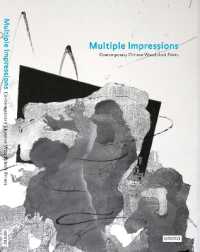Full Description
Quantitative Social Science Research in Practice: Generating Novel and Parsimonious Explanatory Models for Social Sciences examines quantitative Behavioral Science Research (BSR) by focusing on four key areas:
Developing Novel, Parsimonious, and Actionable Causal Models: Researchers often face challenges in creating new, parsimonious causal models supported by empirical evaluation. A promising approach involves using meta-analytic reviews and more recent studies to identify relevant constructs and hypotheses that would constitutethe new causal model.
Exploring the Scope of Context for a Novel Causal Model: The relevance of causal models may vary based on context, such as national or organizational culture, economic and political situations, and feasibility constraints. Behavioural science researchers have struggled to balance rigor and relevance, as theories effective in one context may not be valid in another. This book presents an approach to determine the contextual scope for new causal models.
Guidance to Practice from a Novel Causal Model: Quantitative BSR studies should offer practical guidance, but often this guidance is vague or superficial. This book proposes an approach to highlight actionable insights derived from data analysis of new causal models, ensuring that the research offers concrete guidance for practitioners.
Implementing Guidance from Causal Models: A significant limitation of BSR studies is the lack of clarity on how results can be made actionable for decision-makers, considering the costs and benefits of actions. This book presents a method to make research results actionable, especially for models with high explanatory and predictive power.
The book is designed to be useful for various audiences:
Business Managers and Practitioners: Those conducting or utilizing quantitative BSR for decision-making can find practical approaches for developing and applying causal models.
Master's and PhD Students: Students across disciplines interested in quantitative BSR can gain insight into novel methods for creating strong causal models.
Active Scholars: Researchers aiming to apply new approaches in their work can benefit from the strategies outlined.
Professors and Instructors: Those teaching research methodology or supervising theses can find the book a valuable resource for guiding students in their research projects.
The book aims to advance the field of quantitative BSR by providing robust methodologies for developing, contextualizing, and implementing causal models, ensuring both academic rigor and practical relevance.
Contents
1. Quantitative Behavioural Science Research: Challenges, Prior and New Approaches 2. A Process for Generating Strong, Novel, and Parsimonious Explanatory Models 3. Illustration of the Process for Generating Strong, Novel, and Parsimonious Causal Models 4. Empirical Evaluation of the Causal Model of the Case Study 5. Towards an Exploration of the Scope of Context 6. Towards a Substantive Exploration of Contributions to Practice 7. Towards Making the Results of Likert-Scale Behavioural Science Research Actionable in Organizational Settings Appendix A. Binary Integer Programming Problem - Select the Candidate Models (SCM) Appendix B. Constructs, Measurement Items, Descriptive Statistics , and Sources Appendic C. Otem Loading and Cross Loadings Appendix D. Research Hypotheses of Their Evaluations in This and Previous Studies.







